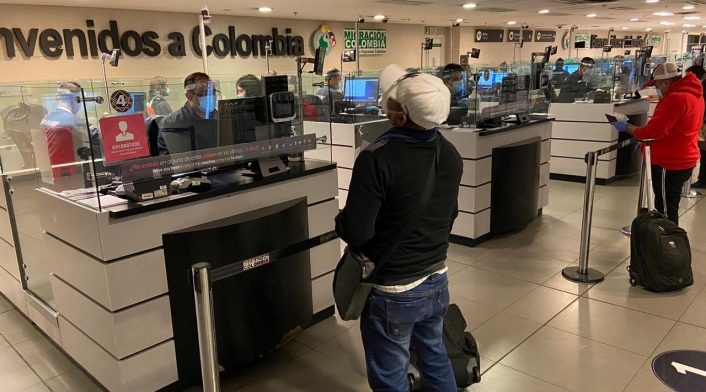Subscribe to our youtube channel today! @medellin_unfiltered
Colombia's Immigration Strike: Long Lines and Frustrated Travelers at Rionegro Airport
What does Colombia's Migracion strike mean for travelers coming and going from Rionegro International Airport.
TRAVEL
Salomé Herrera Lopez
12/4/20243 min read


In Colombia, a nationwide immigration workers’ strike has left travelers frustrated and airport operations in disarray, particularly at José María Córdova International Airport in Rionegro, near Medellín. As one of Colombia's busiest international gateways, Rionegro Airport has become a flashpoint for the logistical challenges posed by the strike. The work stoppage, initiated by the country’s immigration officers, highlights unresolved grievances over pay, working conditions, and understaffing. For travelers, the impact has been immediate and visible: long immigration lines, delayed processing, and an overall chaotic airport experience.
What’s Behind the Strike?
Immigration officers in Colombia, like their counterparts in many other nations, play a vital role in border security and efficient international travel. However, they have been grappling with issues such as low wages, insufficient staffing, and what they describe as an unmanageable workload. The growing influx of travelers—especially as Colombia gains popularity among tourists and digital nomads—has only exacerbated these challenges.
The officers, represented by labor unions, have been negotiating for better conditions with the government for months. Their demands include salary increases, better benefits, and measures to address the chronic understaffing that leaves many officers working long hours under stressful conditions.
With negotiations at a standstill, the union called for a strike, significantly reducing the number of officers available at airports across Colombia, including Rionegro.
The Impact at Rionegro Airport
For travelers arriving at or departing from Medellín, the strike has turned what should be a seamless experience into a test of patience. Rionegro Airport processes thousands of passengers daily, with a substantial proportion being international arrivals. The strike has caused the following ripple effects:
Longer Lines:
Immigration queues at Rionegro Airport now stretch far beyond their usual capacity. Travelers have reported waiting in line for hours, with some even missing connecting flights or important events due to the delays. The reduced workforce has created bottlenecks in both the arrival and departure processes, frustrating passengers and airport staff alike.Flight Delays:
Airlines have had to adjust schedules to accommodate the slower processing times. This has led to delays and disruptions, particularly for flights with tight turnaround times. For airlines, the delays are not just a logistical headache—they can also incur significant costs.Frustrated Travelers:
Passengers arriving at Rionegro Airport have taken to social media to vent their frustrations, sharing images of packed immigration halls and long waits. Many tourists, who are unaccustomed to such delays, find themselves scrambling to make onward travel plans or rearrange itineraries.Stress on Airport Operations:
Airport staff, already stretched thin, are struggling to manage the increased pressure. While some temporary measures have been put in place, such as bringing in personnel from other departments to assist, these are far from sufficient to meet demand.
Broader Implications for Colombia
The strike doesn’t just impact individual travelers; it also has broader implications for Colombia’s reputation as a travel destination. Medellín has worked hard to position itself as a global hotspot for tourism, digital nomadism, and investment. However, first impressions matter, and long immigration lines can tarnish a visitor's experience from the moment they arrive.
Moreover, the strike underscores the strain on Colombia’s infrastructure as it grapples with a surge in international arrivals. While tourism has been a boon to the economy, it has also exposed weaknesses in the country’s ability to handle this growth sustainably.
The delays also affect Colombians traveling abroad, who face similar challenges when departing from international airports. For businesses relying on smooth cross-border travel, such as import/export firms and international consultants, these disruptions can have real financial consequences.
What Can Travelers Do?
For those traveling through Rionegro Airport during the strike, preparation is key. Here are some tips to mitigate the impact:
Arrive Early:
Passengers are advised to arrive at the airport well in advance of their flights, especially for international departures. Three to four hours before departure is recommended.Stay Informed:
Check flight statuses regularly and stay updated on the strike’s progression. Airlines and airports often share real-time updates through social media or apps.Consider Alternatives:
For domestic travelers or those flying regionally, it might be worth exploring alternative entry points into Colombia or different airports within the country to bypass the worst of the delays.Pack Your Patience:
While frustrating, understanding that the strike is rooted in long-standing issues may help travelers approach the situation with empathy. Being polite and patient with airport staff can go a long way.
What’s Next?
Negotiations between the immigration workers’ union and the government are ongoing, but the resolution remains uncertain. The government must balance addressing workers' legitimate concerns with minimizing disruptions to travel and commerce.
Until an agreement is reached, travelers passing through Rionegro Airport and other major Colombian entry points should brace themselves for continued delays. The situation is a stark reminder of the importance of investing in infrastructure and the workforce behind Colombia’s booming tourism sector.
Medellin Unfiltered
Discover the real Medellin, without filters.
CONTACT US
info@medellinunfiltered.com
© 2024 GWM Ventures. All rights reserved.
LEGAL




